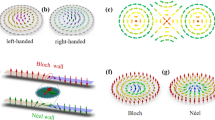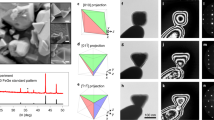Abstract
Topological magnetic domains exhibit many fascinating features and great potential in information storage and spintronics owing to their unique spin textures. In order to investigate the topological properties of the domain structures, the spontaneous evolutions of magnetic moments are evaluated by using Landau–Lifshitz–Gilbert equation. The equilibrium phase diagrams of the system with randomly, radial and axial distributed initial magnetic moments have been studied in detail. Simulation results show that the changes of quality factor (Q) and aspect ratio (T/D) lead to great differences in magnetization process under different initial magnetization states. Vortex, biskyrmion, skyrmion and bubble are formed as the value of Q gradually increases from 0 to 1. The system with Q < 0.5 is easy to stabilize into a vortex state, while the magnetic moments of the system with Q > 1.0 are arranged along the easy axis. When Q and T/D are in the range of 0.6 ~ 0.8 and 0.10 ~ 0.16, respectively, it is conducive to the formation of nontrivial topological domain. Biskyrmion is spontaneously formed in the system of Q = 0.6 and T/D = 0.12, proving that skyrmion-like domain can be generated in the absence of Dzyaloshinskii–Moriya interaction or external field.





Similar content being viewed by others
References
Stamps RL, Breitkreutz S, Akerman J, Chumak AV, Otani Y, Bauer GEW, Thiele JU, Bowen M, Majetich SA, Kläui M, Prejbeanu IL, Dieny B, Dempsey NM, Hillebrands B (2014) The 2014 magnetism roadmap. J Phys D: Appl Phys 47:333001
Eleftheriou E, Haas R, Jelitto J, Lantz M, Pozidis H (2010) Trends in storage technologies. IEEE Data Eng Bull 33:4–13
Krishnan KM, Pakhomov AB, Bao Y, Blomqvist P, Chun Y, Gonzales M, Griffin K, Ji X, Roberts BK (2006) Nanomagnetism and spin electronics: materials, microstructure and novel properties. J Mater Sci 41:793–815. https://doi.org/10.1007/s10853-006-6564-1
Litzius K, Lemesh I, Krüger B, Bassirian P, Caretta L, Richter K, Büttner F, Sato K, Tretiakov OA, Förster J, Reeve RM, Weigand M, Bykova I, Stoll H, Schütz G, Beach GSD, Kläui M (2017) Skyrmion hall effect revealed by direct time-resolved x-ray microscopy. Nat Phys 13:170–175
Liu D, Zhao TY, Shen BG, Li BH, Zhang M, Zuo SL, Liu J, Jiang SD, Hu FX, Sun JR (2020) Microstructures and magnetic properties of Co-substituted Ce-Fe-B amorphous alloys. J Alloy Compd 820:153098
Wintz S, Bunce C, Neudert A, Koerner M, Strache T, Buhl M, Erbe A, Gemming S, Raabe J, Quitmann C, Fassbender J (2013) Topology and origin of effective spin meron pairs in ferromagnetic multilayer elements. Phys Rev Lett 110(17):177201
Mühlbauer S, Binz B, Jonietz F, Pfleiderer C, Rosch A, Neubauer A, Georgii R, Böni P (2009) Skyrmion lattice in a chiral magnet. Science 323:915–919
Jiang WJ, Upadhyaya P, Zhang W, Yu GQ, Jungfleisch MB, Fradin FY, Pearson JE, Tserkovnyak Y, Wang KL, Heinonen O, Velthuis SGE, Axel H (2015) Blowing magnetic skyrmion bubbles. Science 349(6245):283–286
Yu XZ, Tokunaga Y, Taguchi Y, Tokura Y (2017) Variation of topology in magnetic bubbles in a colossal magnetoresistive manganite. Adv Mater 29(3):1603958
Bryant B, Moritomo Y, Tokura Y, Aeppli G (2015) Temperature and field dependence of magnetic domains in La1.2Sr1.8Mn2O7. Phys Rev B 91(13):134408
Mulkers J, Milošević MV, Waeyenberge BV (2016) Cycloidal versus skyrmionic states in mesoscopic chiral magnets. Phys Rev B 93:214405
Mulkers J, Waeyenberge BV, Milošević MV (2017) Effects of spatially engineered Dzyaloshinskii-Moriya interaction in ferromagnetic films. Phys Rev B 95:144401
Balk AL, Kim KW, Pierce DT, Stiles MD, Unguris J, Stavis SM (2017) Simultaneous control of the Dzyaloshinskii-Moriya interaction and magnetic anisotropy in nanomagnetic trilayers. Phys Rev Lett 119:077205
Wells AWJ, Shepley PM, Marrows CH, Moore TA (2017) Effect of interfacial intermixing on the Dzyaloshinskii-Moriya interaction in Pt/Co/Pt. Phys Rev B 95:054428
Cortés-Ortuño D, Romming N, Beg M, Bergmann K, Kubetzka A, Hovorka O, Fangohr H, Wiesendanger R (2019) Nanoscale magnetic skyrmions and target states in confined geometries. Phys Rev B 99:214408
Romming N, Hanneken C, Menzel M, Bickel JE, Wolter B, Bergmann K, Kubetzka A, Wiesendanger R (2013) Writing and deleting single magnetic skyrmions. Science 341:636–639
Miltat JE, Donahue MJ (2007) Handbook of magnetism and advanced magnetic materials, volume micromagnetism. In: Miltat JE, Donahue MJ (eds) Numerical micromagnetic: finite difference methods. Wiley, London
Labrune M, Miltat J (1995) Wall structures in ferro/antiferromagnetic exchange-coupled bilayers: a numerical micromagnetic approach. J Magn Magn Mater 151(12):231245
Landau LD, Lifshitz EM (1935) On the theory of the dispersion of magnetic permeability in ferromagnetic bodies. Phys Z Sowjet 8:153
Huber A, Schäfer R (1998) Magnetic domains: the analysis of magnetic microstructures. Springer, Berlin
Malozemoff AP, Slonczewski JC (1979) Magnetic domain walls in bubble materials. Academic Press, Cambridge
Gilbert TL (2004) A phenomenological theory of damping in ferromagnetic materials. IEEE T Magn 40:3443
Donahue MJ, Porter DG (1999) OOMMF User’s Guide, version 1.0, Interagency Report NISTIR 6376, National Institute of Standards and Technology, Gaithersburg, MD.
Montoya SA, Couture S, Chess JJ, Lee JCT, Kent N, Henze D, Sinha SK, Im MY, Kevan SD, Fischer P, McMorran BJ, Lomakin V, Roy S, Fullerton EE (2017) Tailoring magnetic energies to form dipole skyrmions and skyrmion lattices. Phys Rev B 95(2):024415
Moutafis C, Komineas S, Vaz CAF, Bland JAC, Shima T, Seki T, Takanashi K (2007) Magnetic bubbles in FePt nanodots with perpendicular anisotropy. Phys Rev B 76:104426
d’Albuquerque e Castro J, Altbir D, Retamal JC, Vargas P (2002) Scaling approach to the magnetic phase diagram of nanosized systems. Phys Rev Lett 88:237202
Malozemofflonczewski APJCS (1979) Magnetic domain walls in bubble materials. Academic Press, New York
Iglesias O, Valencia A, Labarta A (1999) Monte carlo simulation of the magnetic ordering in thin films with perpendicular anisotropy. J Magn Magn Mater 819:196–197
Mu Y, Ma YQ (2002) Stripe patterns in frustrated spin systems. J Chem Phys 117:1686
Bogdanov A, Hubert A (1999) The stability of vortex-like structures in uniaxial ferromagnets. J Magn Magn Mater 195:182
Liu Y, Du H, Jia M, Du A (2015) Switching of a target skyrmion by a spin-polarized current. Phys Rev B 91:094425
Zheng FS, Li H, Wang SS, Song DS, Jin CM, Wei WS, Kovacs A, Zang JD, Tian ML, Zhang YH, Du HF, Dunin-Borkowski RE (2017) Direct imaging of a zero-field target skyrmion and its polarity switch in a chiral magnetic nanodisk. Phys Rev Lett 119:197205
Finazzi M, Savoini M, Khorsand AR, Tsukamoto A, Itoh A, Duò L, Kirilyuk A, Rasing T, Ezawa M (2013) Laser-induced magnetic nanostructures with tunable topological properties. Phys Rev Lett 110:177205
Zhang S, Kronast F, Laan GVD, Hesjedal T (2018) Real-space observation of skyrmionium in a ferromagnet-magnetic topological insulator heterostructure. Nano Lett 18(2):1057–1063
Loudon JC, Twitchett-Harrison AC, Cortés-Ortuño D, Birch MT, Turnbull LA, Štefančič A, Ogrin FY, Burgos-Parra EO, Bukin N, Laurenson A, Popescu H, Beg M, Hovorka O, Fangohr H, Midgley PA, Balakrishnan G, Hatton PD (2019) Do images of biskyrmions show type-II bubbles? Adv Mater 31(16):1806598
Yao Y, Ding B, Cui J, Shen X, Wang YG, Wang WH, Yu RC (2019) Magnetic hard nanobubble: a possible magnetization structure behind the bi-skyrmion. Appl Phys Lett 114:102404
Parkin SSP (2004) Shiftable magnetic shift register and method of using the same. US Patent 6, 834:005.
Sampaio J, Cros V, Rohart S, Thiaville A, Fert A (2013) Nucleation, stability and current-induced motion of isolated magnetic skyrmions in nanostructures. Nat Nanotechnol 8:839–844
Wang WH, Zhang Y, Xu GZ, Peng LC, Ding B, Wang Y, Hou ZP, Zhang XM, Li XY, Liu EK, Cai JW, Wang FW, Li JQ, Hu FX, Wu GH, Shen BG, Zhang XX (2016) A centrosymmetric hexagonal magnet with superstable biskyrmion magnetic nanodomains in a wide temperature range of 100–340 K. Adv Mater 28:6887–6893
Yu XZ, Tokunaga Y, Kaneko Y, Zhang WZ, Kimoto K, Matsui Y, Taguchi Y, Tokura Y (2014) Biskyrmion states and their current-driven motion in a layered manganite. Nat Commun 5:3198
Acknowledgements
This work was supported by the National Natural Science Foundation of China (Grant Nos. 52001012, 51701130, 51590880, 62075245); the National Key Research and Development Program of China (Grant No. 2016YFB0700903); the Fujian Institute of Innovation, Chinese Academy of Sciences (Grant No. FJCXY18040302); the Science Foundation of Ministry of Education of Beijing (Grant No. KZ201810011013); the Inner Mongolia Science and Technology Major Project of China 2016; and the Research Foundation for Youth Scholars of Beijing Technology and Business University (Grant No. PXM2020_014213_000017).
Author information
Authors and Affiliations
Corresponding authors
Ethics declarations
Conflict of interest
All authors declare that no conflict of interest exists in the submission of this manuscript. We have no financial and personal relationships with other people or organizations that can inappropriately influence our work.
Additional information
Handling Editor: Yaroslava Yingling.
Publisher's Note
Springer Nature remains neutral with regard to jurisdictional claims in published maps and institutional affiliations.
Rights and permissions
About this article
Cite this article
Liu, D., Zhao, T., Zhang, M. et al. Exploration of nontrivial topological domain structures in the equilibrium state of magnetic nanodisks. J Mater Sci 56, 4677–4685 (2021). https://doi.org/10.1007/s10853-020-05569-4
Received:
Accepted:
Published:
Issue Date:
DOI: https://doi.org/10.1007/s10853-020-05569-4




